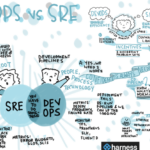Site Reliability Engineering (SRE) is a methodology that emerged from Google’s experience of running large-scale, complex systems. It’s a set of practices that aims to improve the reliability, scalability, and performance of software systems. SRE is a combination of software engineering, operations, and systems administration. SRE teams are responsible for maintaining the production systems, ensuring that they are reliable, efficient, and available to users.
Benefits of SRE
SRE can bring many benefits to software development. Here are some of the most significant benefits:
Improved reliability and availability: SRE practices help to improve the reliability and availability of software systems. This means that users can access the system when they need it, and it works as expected.
Increased scalability: SRE practices also help to increase the scalability of software systems. This means that the system can handle more traffic and users without degrading performance.
Faster incident response: SRE teams are responsible for responding to incidents and restoring services as quickly as possible. This means that downtime is minimized, and users can continue to use the system without interruption.
Better performance: SRE practices can help to improve the performance of software systems. This means that users can interact with the system more quickly and efficiently.
Cost savings: By improving reliability, scalability, and performance, SRE can help to reduce costs associated with downtime, maintenance, and upgrades.
How to start with SRE
If you want to start with SRE, here are some steps to follow:
Define your SRE goals: Before you can start with SRE, you need to define your goals. What do you want to achieve with SRE? What are your key performance indicators (KPIs)?
Build an SRE team: You will need to build an SRE team that has the skills and expertise to manage and maintain your software systems. This team should consist of software engineers, operations experts, and systems administrators.
Define your SRE processes: You need to define the processes that your SRE team will use to manage and maintain your software systems. This includes incident response processes, change management processes, and monitoring processes.
Implement SRE tools: You will need to implement SRE tools that help your SRE team to manage and maintain your software systems. This includes monitoring tools, alerting tools, and automation tools.
Measure and improve: Finally, you need to measure the performance of your SRE team and systems and continuously improve your SRE processes and tools.
How to implement SRE
Here are some steps to implement SRE:
Develop a service-level objective (SLO): The first step in implementing SRE is to develop an SLO. An SLO defines the level of service that you want to provide to your users. It includes metrics such as uptime, response time, and error rate.
Set up monitoring and alerting: You need to set up monitoring and alerting tools that allow you to track the performance of your systems and alert you when there are issues. This includes setting up dashboards that display key metrics and setting up alerts that notify you when those metrics fall below acceptable levels.
Automate where possible: Automation is key to implementing SRE. You need to automate tasks such as deployment, configuration management, and incident response to reduce the time and effort required to manage your systems.
Establish incident response processes: You need to establish incident response processes that allow your SRE team to respond quickly and effectively to incidents. This includes defining roles and responsibilities, establishing communication channels, and creating runbooks that document the steps required to resolve common incidents.
Conduct post-incident reviews: After an incident has been resolved, you need to conduct a post-incident review. This involves analyzing what happened, identifying the root cause of the incident, and making changes to prevent similar incidents from occurring in the future.
Continuously improve: SRE is a continuous process of improvement. You need to constantly review and improve your SLOs, monitoring and alerting tools, automation, incident response processes, and post-incident reviews to ensure that you are providing the best possible service to your users.
Strategies for SRE
Here are some strategies for implementing SRE:
Define your service boundaries: You need to define your service boundaries and the dependencies between your services. This helps you to understand the impact of changes and incidents on your systems.
Implement progressive delivery: Progressive delivery is a strategy that involves gradually rolling out changes to your systems to minimize the risk of incidents. This involves using techniques such as canary releases and feature flags.
Practice chaos engineering: Chaos engineering is a strategy that involves deliberately introducing failures into your systems to test their resilience. This helps you to identify weaknesses in your systems and make improvements.
Use blameless post-mortems: Blameless post-mortems are a strategy that involves conducting post-incident reviews without assigning blame to individuals or teams. This helps to create a culture of learning and continuous improvement.
Tools for SRE
Here are some tools for implementing SRE:
Monitoring tools: Monitoring tools such as Prometheus, Grafana, and Datadog allow you to collect and visualize metrics about your systems.
Alerting tools: Alerting tools such as PagerDuty, VictorOps, and OpsGenie allow you to set up alerts that notify you when there are issues with your systems.
Automation tools: Automation tools such as Terraform, Ansible, and Puppet allow you to automate tasks such as deployment, configuration management, and incident response.
Collaboration tools: Collaboration tools such as Slack, Microsoft Teams, and Zoom allow your SRE team to communicate effectively and collaborate on tasks.
Incident management tools: Incident management tools such as Statuspage, Jira Service Desk, and Zendesk allow you to manage and track incidents and communicate with your users.
Conclusion
SRE is a methodology that can bring many benefits to software development, including improved reliability, scalability, and performance, faster incident response, better performance, and cost savings. To start with SRE, you need to define your goals, build an SRE team, define your processes, implement SRE tools, and measure and improve. To implement SRE, you need to develop an SLO, set up monitoring and alerting, automate where possible, establish incident response processes, conduct post-incident reviews, and continuously improve. Strategies for SRE include defining service boundaries, implementing progressive delivery, practicing chaos engineering, and using blameless post-mortems. Tools for SRE include monitoring tools, alerting tools, automation tools, collaboration tools, and incident management tools. If you’re interested in implementing SRE for your software development, contact us to learn more about how we can help you.


